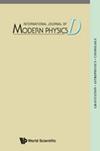量子黑洞是经典的空间工厂
IF 2.1
4区 物理与天体物理
Q3 ASTRONOMY & ASTROPHYSICS
引用次数: 2
摘要
空间和物质可能都是单一基本量子动力学的表现,这一点在黑洞蒸发过程中可能变得很明显。受量子电动力学是经典弹性理论的基础这一事实的启发,而经典弹性理论反过来又具有与拓扑缺陷相关的曲率和扭转的自然和众所周知的几何描述,在这里,我们移动了一些必要的步骤来寻找从这种基本量子水平到经典空间和量子物质的新兴水平的映射。我们将标准量子场论的玻色子变换方法应用于量子引力的基本场景,并成功地得到了曲率和扭转的出现,这是我们的主要关注点。在这样做的过程中,我们已经能够克服解释的困难问题,与旋转对称的戈德斯通模式有关。事实上,我们已经能够将玻色子变换方法应用于偏差,将它们与自旋结构联系起来,并给出弯曲空间上物质场方程的启发式推导。我们还改进了以前关于弹性理论中几何张量出现的工作结果,因为那些论文中假设的扭转张量和曲率张量的非阿贝尔贡献在这里自然出现。需要做更多的工作来确定用这种方法可以得到的引力理论的类型。本文章由计算机程序翻译,如有差异,请以英文原文为准。
Quantum black holes as classical space factories
Space and matter may both be manifestations of a single fundamental quantum dynamics, as it may become evident during black-hole evaporation. Inspired by the fact that quantum electrodynamics underlies the classical theory of elasticity, that in turn has a natural and well-known geometric description in terms of curvature and torsion, related to topological defects, here we move some necessary steps to find the map from such fundamental quantum level to the emergent level of classical space and quantum matter. We proceed by adapting the boson transformation method of standard quantum field theory to the quantum gravity fundamental scenario and successfully obtain the emergence of curvature and torsion, our main focus here. In doing so, we have been able to overcome difficult issues of interpretation, related to the Goldstone modes for rotational symmetry. In fact, we have been able to apply the boson transformation method to disclinations, to relate them to the spin structure and to give an heuristic derivation of the matter field equation on curved space. We also improve results of previous work on the emergence of geometric tensors from elasticity theory, as the non-Abelian contributions to the torsion and curvature tensors, postulated in those papers, here emerge naturally. More work is necessary to identify the type of gravity theories one can obtain in this way.
求助全文
通过发布文献求助,成功后即可免费获取论文全文。
去求助
来源期刊

International Journal of Modern Physics D
地学天文-天文与天体物理
CiteScore
3.80
自引率
9.10%
发文量
181
审稿时长
4-8 weeks
期刊介绍:
Gravitation, astrophysics and cosmology are exciting and rapidly advancing fields of research. This journal aims to accommodate and promote this expansion of information and ideas and it features research papers and reviews on theoretical, observational and experimental findings in these fields. Among the topics covered are general relativity, quantum gravity, gravitational experiments, quantum cosmology, observational cosmology, particle cosmology, large scale structure, high energy astrophysics, compact objects, cosmic particles and radiation.
 求助内容:
求助内容: 应助结果提醒方式:
应助结果提醒方式:


